The ideal option for individual heating! Solid fuel boilers for the home: their types and operating principles
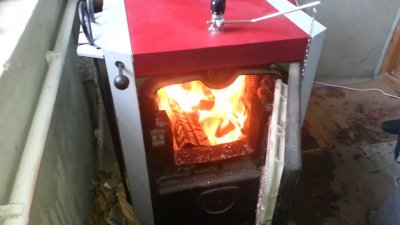
In those areas where there is no possibility of connecting to the main gas, heating with wood materials is widespread. Traditional stoves have lower efficiency.
Therefore, a system with a solid fuel boiler is often used. What is required of him economy, efficiency and long service life.
Content
Types of solid fuel boilers for heating a private house
Differences in solid fuel boilers related to:
- Resource supply technology.
- The existing combustion system.
Pellet
Automatic loading is carried out from the bunker. Depending on its volume, one bookmark is enough for a period from a week to a month. Since the solid fuel boiler operates independently, it is possible to adjust the heating modes depending on depending on the time of day and day of the week.
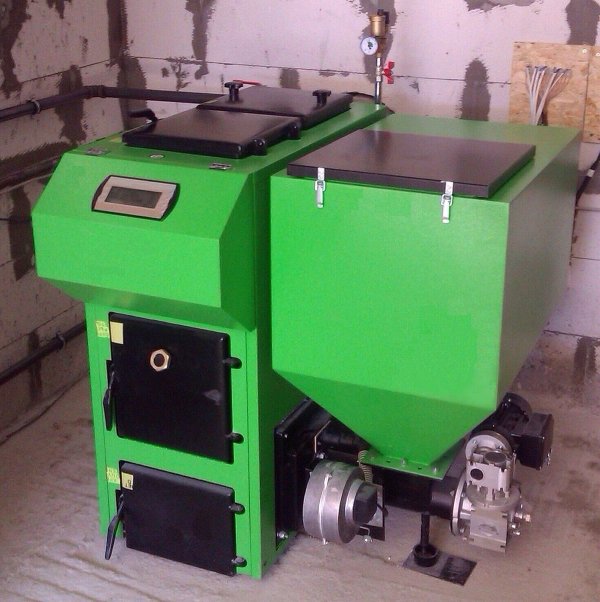
Photo 1. Solid fuel pellet boiler. On the right side of the device there is a hopper for loading pellets.
Automatic models solid fuel boilers work only on pellets. These are wood pellets that are obtained by pressing sawdust, shavings, bark, husks and other similar wood waste. Pellets do not burn, but smolder for a long time, releasing a significant amount of heat. Therefore, they give quite high efficiency, up to 90-95%.
Important! Due to automation it will be required constant source of electricity. In case of power outages, it is advisable to purchase a UPS.
With manual loading
Other types of solid fuel boilers are loaded only manually. The heat source is:
- firewood;
- coal;
- shtyb;
- coke;
- briquettes;
- peat.
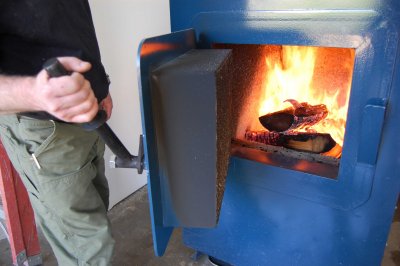
The lifespan of one bookmark depends on the volume of the fuel chamber and the combustion technologies used. For convenience, the boiler door is positioned at an angle. This facilitates loading and further maintenance of the device.
The disadvantage of such models of solid fuel boilers is impossibility of automatic operation. To maintain the process, periodic human efforts are required.
But the dependence on electricity is reduced. In addition, different types of resources are used and it is easier to select the most accessible ones in a given area.
Reference. There are models of solid fuel boilers with automatic and mechanical temperature controlIn the latter case, a mechanical draft regulator (damper) is used. It does not depend on the presence of electricity.
Solid fuel boilers with manual loading are divided into types depending on their design features. The following technologies are distinguished:
- classical;
- pyrolysis;
- long burning.
Classic
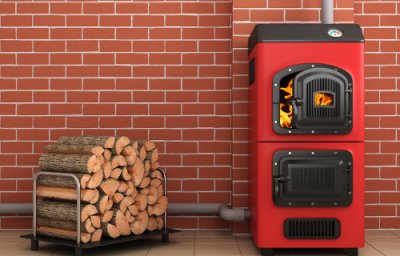
Such solid fuel boilers do not use technologies that increase the duration and efficiency of combustion. Therefore the wood burns quickly in them, in a few hours.
The efficiency of such boilers is low, since a significant portion of the heat escapes through the chimney.
The advantages of such models of solid fuel boilers refers to low cost, due to the fact that the internal structure is simple.
Pyrolysis
As the name suggests, Pyrolysis combustion technology is used. During primary combustion with a lack of oxygen, pyrolysis gases are formed, which are also capable of burning, releasing a significant amount of heat.
The design is more complicated than the classic version. solid fuel boilers. An additional combustion chamber is located above the main combustion chamber, where gases are collected and burned.
Thanks to this increase:
- efficiency (up to 85-95% depending on the type of raw material);
- duration work of one bookmark.
Other advantages of such solid fuel boilers include precise temperature control and less soot and slag. Disadvantages boilers are considered:
- Tall price (pays for itself during operation).
- Necessity of use dry fuel only (otherwise the pyrolysis process will not start).
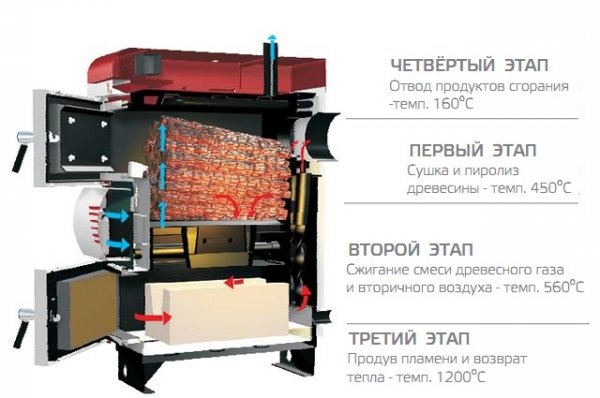
Photo 2. Internal structure of a solid fuel pyrolysis boiler and principles of its operation at different stages.
Long burning
Solid fuel boilers of this type use a different technology. The wood does not burn from the bottom up, as in the classic version, but top down. The combustion becomes slow and efficient. Therefore, the loading of firewood into the boiler is sufficient up to a day or more, and coal - up to a week. Like pyrolysis boilers, these solid fuel boilers operate on all types of wood resources.
Recommendations for choosing a solid fuel boiler
Among the variety of solid fuel boiler options, it is important to choose which one will best suit specific conditions. both the parameters of the house and the surrounding conditions.
Fuel used
When choosing a solid fuel boiler The following parameters are taken into account:
- price;
- Efficiency;
- running time of one download;
- prevalence in a given area.
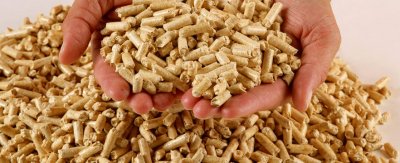
Fuel is loaded into solid fuel pellet boilers up to once a month, into coal boilers - once every few days. Wood boilers operate on one load no more than a day.
If possible, it is better to install a heating boiler that requires less maintenance. But if you can buy, for example, only without problems and interruptions firewood, you will have to choose them.
Construction structure
Automatic loading makes the process of heating your home much easier, but Such solid fuel boilers require electricity. Therefore, this method is not suitable for summer cottages, where there are frequent power outages or the allocated electrical power is barely enough for other needs.
It is better to choose from the types of boiler design pyrolysis or long burning. In them, resources are spent more efficiently, that is, costs are reduced.
Power
This parameter determines, what is the area of the house the installed solid fuel boiler will be able to heat. If it is not enough, it will be too cold. But you should not choose with a large reserve either.
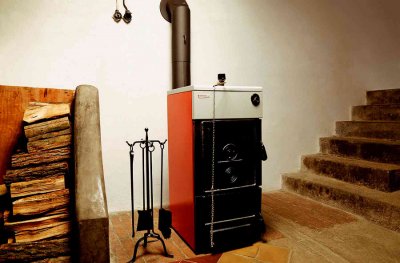
Otherwise, the room will be too hot. In addition, heating costs will increase significantly.
To determine the required boiler power, calculate heat loss of the house. They depend on its size, materials and climate.
But for an approximate calculation it is enough to know the total area. 1 kW enough for heating 10 sq. m. at ceiling height about 2.5-2.7 meters.
Special coefficients are used to take into account climatic conditions. The resulting value is multiplied by:
- 1.5-2 for northern regions;
- 1-1,2 for the middle zone;
- 0.7-0.9 for the southern regions.
These calculations are only valid for heating the house. If you also plan to heat water for household needs, the power increases even more. by 20-25%.
Dimensions and weight of the device
The size of the solid fuel boiler determines what kind of furnace is required. The distance to the walls should be not less than 20-25 cm.
Pellet solid fuel boilers with automatic loading take up more space. The bunker is sometimes larger in size than the device itself.
In general, all solid fuel heating boilers are distinguished by their significant weight. Therefore They are placed on the floor rather than hung on the wall.
Reference. Cast iron solid fuel boilers heavier than steel. They often require the installation of a foundation.
Number of contours
Single-circuit models boilers perform only one function - heating the house. To heat water, you will have to use other technologies.
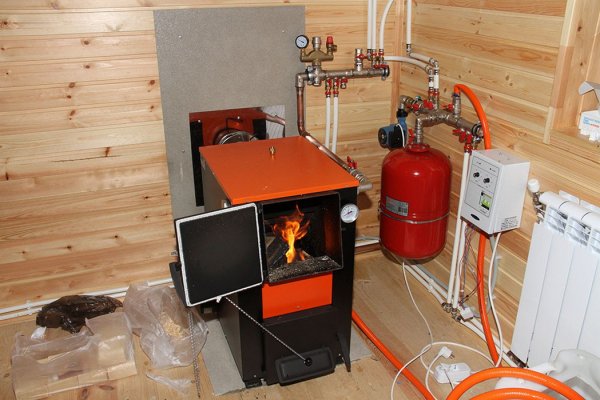
Photo 3. Single-circuit solid fuel boiler. It is connected to the heating system through which the coolant circulates.
In a dual circuit solid fuel boiler two outlet pipes. A radiator system is connected to one of them, and water for household needs comes out of the other. This is more convenient - you won't need a second device, but the consumption of resources will increase. And if it breaks down, there will be no heat or hot water.
Additional functions
In some models of solid fuel boilers one or more of the following functions are present:
- A hob that allows you to cook food. This is especially convenient for small homes.
- Automatic ignition of firewood.
- A sensor that monitors pressure levels.
- Thermal accumulator.
Heat accumulator - a tank filled with water. It is located on the chimney or connected separately. During combustion, the water in it heats up. Then it is used for household needs or (less often) is used for heating (after the "main" liquid in the system has cooled down). The use of this technology makes the equipment more efficient.
Rules for the use of solid fuel boiler equipment
Proper operation of a solid fuel boiler is the key to efficiency, safety and long service. Solid fuel boilers must be regularly inspected and serviced. It is important to choose the most suitable type of wood fuel.
Fuel
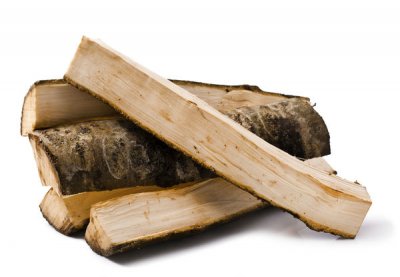
For maximum efficiency, it is recommended:
- Use dry wood (coal, briquettes, pellets).
- Stick to the type of resource recommended by the manufacturer (otherwise up to 30% of efficiency is lost).
In wood-burning models For solid fuel boilers, it is recommended to place larger pieces of wood in the center of the firebox, and small kindling at the edges.
When heated with coal sift the ash. It contains large fragments that are added again. This happens because a large chamber is required for complete combustion.
Attention! In boilers designed for firewood, You can't burn coal! In this case, the temperature becomes too high and there is a risk of breakage.
To prepare in a timely manner, it is important to know how many resources are being consumed. for a certain time (day, month, season)To do this, the required power is multiplied by the average calorific value. It is approximately:
- 3.4 kW/h for firewood;
- 4.2 kW/h for pellets;
- And 7.75 kW/h for anthracite.
Important! The solid fuel heater does not operate continuously. For automatic models, this time is about 10-12 hours a day.
How to properly and safely load fuel into a boiler
Before kindling solid fuel boiler is required:
- Make sure there are no cracks.
- Remove ash and slag.
The method of kindling depends on the type of solid fuel boiler. In a classic boiler, first light the some firewood, wood chips or paper. And only after burning out, add to the full "portion". When using pyrolysis or long-term combustion technologies, a full load is immediately produced.
Attention! Cannot be used to light a boiler gasoline, kerosene, and also household waste.
How to maintain a stove
During the operation of solid fuel boilers, soot and slag are formed. Their accumulation reduces productivity and efficiency. Therefore The ovens are cleaned periodically.
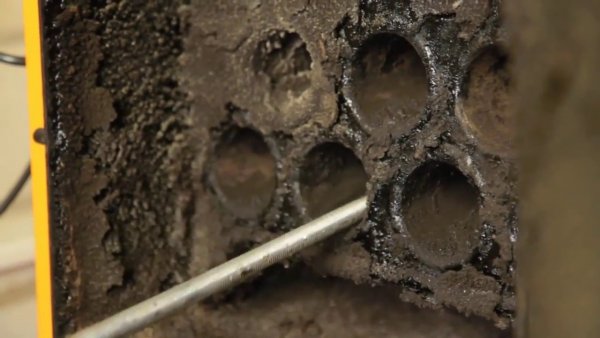
Photo 4. The process of cleaning a solid fuel boiler. Special scrapers are used to remove contaminants.
To avoid getting burned in the process, This is done after the inner surface has cooled. Only dry cleaning method is used. Resin is removed with a special scraper. Finally, the internal surfaces are wiped with a dry cloth.
Reference. If heating is not planned during the winter, all water is drained from the system. Otherwise it will freeze and burst the walls. Another option is adding antifreeze.
Useful video
Watch a video that talks about the principles of choosing a solid fuel boiler for heating a private home.
Pros and cons of devices
Advantages solid fuel boilers:
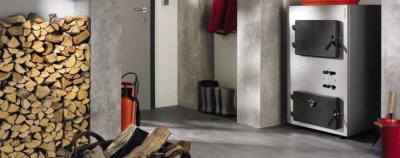
- Possibility of heating in places where there is no gas, and sometimes even electricity.
- Cost savings compared to electric heating.
- Quite a long service life (due to the simplicity of the design).
- A variety of options for the resources and designs used.
- Easy to install.
Flaws solid fuel boilers:
- Low level of automation (except pellet ones).
- The need for storage space for firewood, coal, pellets.







Comments